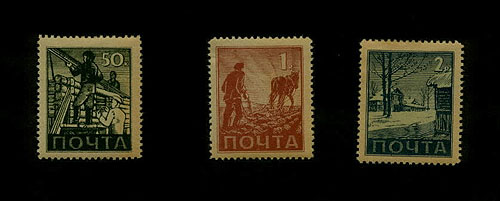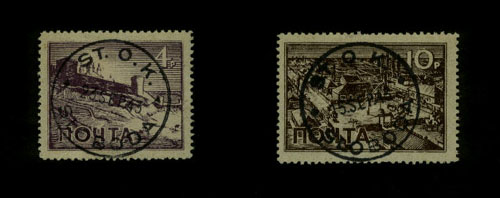Russian
Legion Stamps and Postal History
|
Introduction
One
of the first Russian volunteer formations was the Russian National
Army of Liberation known as "RONA." Organized in the winter of
1941-42 under the command of a Russian Captain named Kaminski.
This force, which never exceeded a division fought mainly anti-Partisans
in the Bryansk region and later sent to the front lines. In the
summer 1944, it was organized under the Waffen-SS as a brigade.
This SS-Brigade, which was referred as Kaminski's Brigade obtained
a gruesome fame in the Warsaw uprising. After the battle Kaminski
was shot by order of Himmler and the remnants of his brigade sent
to the Vlasov Army.
In Germany a former distinguished Russian
General who was captured convinced his German captors that he
could obtained enough loyal volunteers to fight against the Stalin
regime. His name was General Andrei Andreevich Vlasov. Early in
1943, with German approval Vlasov formed a national committee
and created the
"Russkaia Osvoditelnaia Armiia (ROA)" (Russian Liberation Army). However there were problems with the
organization from the start, since half of the eastern volunteers were opposed
of joining Vlasov's Army. Most of them wouldn't consider themselves
Russians and wanted their respective countries liberated from
Russian rule.
In September 1944, Himmler met with General Vlassov,
which resulted to the creation of a new committee, called
"Komitet Osvobozhdyeniya Narodov Rossii, (KONR)"
(Committee for the Liberation of the People's of Russia). This Committee and
Vlassov's Army were to embrace all Soviet citizens living under German jurisdiction.
Himmler promised to help with the formation of the KONR Army.
Because of the majority of ROA Troops were engaged in different
fronts, their transfer to the KONR Army was to take place gradually.
Unfortunately once again, uniting all these different nationalities
into KONR formation cause problems to the Germans. Eventually
various eastern national groups agreed to join Valssov's KONR
Army.
In November 1944, the first KONR Division was organized
in the Troop Training Grounds in Muensingen. In mid-February 1945,
operational readiness was established and the KONR Division was
designated as the
"600. Infanterie-Division (Russ.)" under the
Command of General Sergei Kuzmich Bunyachenko. The nucleus of
the division consisted of remnants of the 30th SS Russian Infantry
Division, which was never completed, and remnants of the Kaminski
Brigade. The 600th Infantry Division was greatly under strength
with acute shortages of weapons, equipment and supplies, nevertheless
it reach the front lines on the Oder in March 1945.
In January
1945, a 2nd KONR Division under the command of General Zveryev
was organized and designated as the "650. Infanterie-Division (Russ.)."
Unfortunately it never reached its operational readiness
because of shortages in arms and supplies. In April 1945, another
Russian formation referred as "Russische Brigade 599" was organized
and located in Viborg, Denmark. The 1st KONR Division was given
the task of capturing the Soviet stronghold in the area of Frankfurt-on-Oder.
The offensive attack committed by the troops of the 1st KONR Division
failed, with heavy losses owing to the lack of adequate artillery
and air power. After the failure of this attack, the 1st KONR
Division was withdrawn and began the march towards the Czech frontier.
By the end of the war all major Russian, Cossack and Eastern Volunteer
formations had attempted to surrender to Western allies. However
practically all the major units were handed back to the Soviets
by the Western Allies. There were only two major Russian formations
that were not turned over to the Soviets. The Russian Defense
Corps in Serbia, formed from White Russian exiles and the Ukrainians.
The White Russians had taken refuge in Serbia in 1921, and were
considered Yugoslav citizens. The Ukrainians from the 1st Division
were placed in POW Camps in Rimini, Italy. They were able to argue
from their British captors that they were Polish citizens. It
should be noted that the Germans conscripted between 2 to 4 million
forced laborers from the former Soviet territories to work in
the Third Reich. These labors were called "Ostarbeiters" (Eastern
workers). By 1944, there were six million people deported from
the Soviet Union.
|
|
Russian
Legion Postal Issues

So-called
Vlassov postal Issues
The
postal issues shown were issued in July 1943. The German
propaganda section of the Postal Ministry issued a set of five
stamps. These stamps were somehow connected to the rump Russian
Liberation Army formed by Vlasov's committee. However it is more
likely that the stamps were issued for the semi-autonomous Ukrainian
government. The stamps consist of the following:
50
Kop (Green) Log house being built.
1
Rub (Red) Farmer plowing.
2 Rub (Blue) Village scene in winter.
4 Rub (Mauve) Kremlin & cathedral on top of a hill at Pskov.
10
Rub (Brown) Aerial view of a village.
The stamps have the inscription Post in Russian cyrillic. There were
16,300 sets of five printed. These stamps are also found with dated office cancels
from the town of Sloboda in the Ukraine.

Russian
Postal Issues
|
|
Postal
History
In 1943, Russian personnel serving with the German Wehrmacht were
assigned Feldpost numbers and were entitled to mail privileges.
Mail was censored and sent only to territories occupied by the
Germans. For mail weighing between 250 and 1000gms, a 20Rpf postal
fee was charged.
German regular Hitler o/p stamps were used in
Russia. For mail used in the Baltic Countries or northwestern
territories, the stamps were overprinted with the inscription
"OSTLAND." For mail used in the southeastern territories the stamps
were overprinted with inscription "UKRAINE." These stamps were
used extensively in Russia.
For Feldpost usage these stamps were
required to cover postal fees for parcel, express and registered
mail. Initially all Russian personnel in the military were provided
with bilingual Feldpost cards. Privileges were limited to sending
two cards with reply card each month. These cards were limited
to Russian areas occupied by the Axis forces. The cards bore the
inscription: Feldpost "Postdienst fuer ehemalige russische Kriegs-gefangene."
These cards were censored by the unit and weren't sent to censorship
offices. If mail entered the civil postal service and was addressed
on the card to an area served by the Deutsche Dienstpost, then
it was forwarded directly to the town named. However if addressee
lived in a district under direct military rule close to the fighting
line, then it had to be sent to the "Postsammelstelle Berlin"
(Mail Collecting Office Berlin) for transmission through Feldpost
channels.
[ Front
Page ] [ Top] [Previous
Page [ Next Page]
|
|

